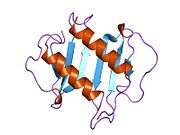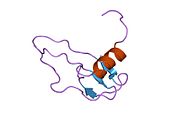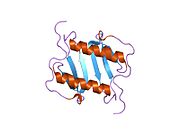Interleukin 8
Ensembl |
| ||||||||
|---|---|---|---|---|---|---|---|---|---|
| UniProt |
| ||||||||
| RefSeq (mRNA) |
| ||||||||
| RefSeq (protein) |
| ||||||||
| Location (UCSC) | Chr 4: 73.74 – 73.74 Mb | n/a | |||||||
| PubMed search | [2] | n/a | |||||||
| View/Edit Human | |||
Interleukin 8 (IL-8 or chemokine (C-X-C motif) ligand 8, CXCL8) is a
There are many receptors on the surface membrane capable of binding IL-8; the most frequently studied types are the G protein-coupled serpentine receptors CXCR1 and CXCR2. Expression and affinity for IL-8 differs between the two receptors (CXCR1 > CXCR2). Through a chain of biochemical reactions, IL-8 is secreted and is an important mediator of the immune reaction in the innate immune system response.
Function
IL-8, also known as neutrophil chemotactic factor, has two primary functions. It induces chemotaxis in target cells, primarily neutrophils but also other granulocytes, causing them to migrate toward the site of infection. IL-8 also stimulates phagocytosis once they have arrived. IL-8 is also known to be a potent promoter of angiogenesis. In target cells, IL-8 induces a series of physiological responses required for migration and phagocytosis, such as increases in intracellular Ca2+, exocytosis (e.g. histamine release), and the respiratory burst.
IL-8 can be secreted by any cells with
IL-8 is believed to play a role in the pathogenesis of bronchiolitis, a common respiratory tract disease caused by viral infection.[citation needed]
IL-8 is a member of the CXC chemokine family. The genes encoding this and the other ten members of the CXC chemokine family form a cluster in a region mapped to chromosome 4q.[6][9]
CXCL-8 mediated chemotaxis of the neutrophil
CXCL8 is the primary
Firstly, at the site of infection
Once the neutrophil is rolling along the endothelium, it will come into contact with a CXCL8 molecule expressed on the surface which stimulates the cell signalling pathway, mediated through a G-coupled-protein-receptor. The binding of CXCL8 to CXCR1/2 on the neutrophil stimulates the neutrophils to upregulate their expression of the integrin, LFA-1, which takes part in high affinity bonding with ICAM-1 receptors expressed on the endothelium. The expression and affinity of LFA-1 is significantly increased to maximise binding. This causes the neutrophil to slow down more until it is stationary. Another key function of the cell signalling stimulated by CXCL8, is the initiation of the oxidative burst. This process allows the build up of proteolytic enzymes and reactive oxygen species (ROS) which are necessary to break down the ECM and basement membrane. These are released in secretory granules, along with more integrins. The release of ROS and damaging enzymes is regulated to minimise host damage, but continues to reach site of infection at which it will carry out its effector functions.[10]
Target cells
While neutrophil granulocytes are the primary target cells of IL-8, there are a relatively wide range of cells (
Clinical significance
Interleukin-8 is a key mediator associated with inflammation where it plays a key role in neutrophil recruitment and neutrophil degranulation.[12] As an example, it has been cited as a proinflammatory mediator in gingivitis[13] and psoriasis.
Interleukin-8 secretion is increased by oxidant stress, which thereby cause the recruitment of inflammatory cells and induces a further increase in oxidant stress mediators, making it a key parameter in localized inflammation.[14] IL-8 was shown to be associated with obesity.[15]
IL-8 has also been implied to have a role in colorectal cancer by acting as an
If a pregnant mother has high levels of interleukin-8, there is an increased risk of schizophrenia in her offspring.[19] High levels of Interleukin 8 have been shown to reduce the likelihood of positive responses to antipsychotic medication in schizophrenia.[20]
IL-8 has also been implicated in the pathology of cystic fibrosis. Through its action as a signalling molecule IL-8 is capable of recruiting and guiding neutrophils to the lung epithelium. Overstimulation and dysfunction of these recruited neutrophils within the airways results in release of a number of pro-inflammatory molecules and proteases resulting in further damage of lung tissue.[21]
Some
Regulation of expression
The expression of IL-8 is negatively regulated by a number of mechanisms. MiRNA-146a/b-5p indirectly represses IL-8 expression by silencing the expression of
Nomenclature
IL-8 was renamed CXCL8 by the Chemokine Nomenclature Subcommittee of the International Union of Immunological Societies,.[26] Its approved HUGO gene symbol is CXCL8. Its receptors were similarly renamed:
- Interleukin 8 receptor, alpha — CXCR1
- Interleukin 8 receptor, beta — CXCR2
References
- ^ a b c GRCh38: Ensembl release 89: ENSG00000169429 – Ensembl, May 2017
- ^ "Human PubMed Reference:". National Center for Biotechnology Information, U.S. National Library of Medicine.
- PMID 10873157.
- PMID 9802987.
- PMID 9802986.
- ^ S2CID 2217894.
- ^ PMID 15831231.
- PMID 28814669.
- ^ "Entrez Gene: IL8 interleukin 8".
- ^ PMID 22787461.
- S2CID 33755476.
- S2CID 8035653. Archived from the originalon 2016-07-27.
- ^ Haake, SK, Huang, GTJ: Molecular Biology of the host-Microbe Interaction in Periodontal Diseases (Selected Topics). In Newman, Takei, Carranza, editors: Clinical Periodontology, 9th Edition. Philadelphia: W.B.Saunders Co. 2002. page 162.
- S2CID 25974629.
- S2CID 36127785.
- PMID 10623446.
- PMID 15749028.
- ^ Milosevic, V. et al. Wnt/IL-1β/IL-8 autocrine circuitries control chemoresistance in mesothelioma initiating cells by inducing ABCB5.Int. J. Cancer, https://doi.org/10.1002/ijc.32419
- PMID 15121655.
- PMID 15291683.
- PMID 21330456.
- PMID 23266380.
- PMID 20148189.
- PMID 19284656.
- PMID 30969964.
- PMID 12433287.
Further reading
- Milosevic V, et al. (January 2020). "Wnt/IL-1β/IL-8 autocrine circuitries control chemoresistance in mesothelioma initiating cells by inducing ABCB5". Int. J. Cancer. 146 (1): 192–207. S2CID 160014053.
- Baggiolini M, Clark-Lewis I (1992). "Interleukin-8, a chemotactic and inflammatory cytokine". FEBS Lett. 307 (1): 97–101. S2CID 10615150.
- Wahl SM, Greenwell-Wild T, Hale-Donze H, Moutsopoulos N, Orenstein JM (2000). "Permissive factors for HIV-1 infection of macrophages". J. Leukoc. Biol. 68 (3): 303–10. S2CID 41684404.
- Starckx S, Van den Steen PE, Wuyts A, Van Damme J, Opdenakker G (2002). "Neutrophil gelatinase B and chemokines in leukocytosis and stem cell mobilization". Leuk. Lymphoma. 43 (2): 233–41. S2CID 940921.
- Smirnova MG, Kiselev SL, Gnuchev NV, Birchall JP, Pearson JP (2003). "Role of the pro-inflammatory cytokines tumor necrosis factor-alpha, interleukin-1 beta, interleukin-6 and interleukin-8 in the pathogenesis of the otitis media with effusion". Eur. Cytokine Netw. 13 (2): 161–72. PMID 12101072.
- Struyf S, Proost P, Van Damme J (2003). Regulation of the Immune Response by the Interaction of Chemokines and Proteases. Advances in Immunology. Vol. 81. pp. 1–44. PMID 14711052.
- Chakravorty M, Ghosh A, Choudhury A, Santra A, Hembrum J, Roychoudhury S (2004). "Ethnic differences in allele distribution for the IL8 and IL1B genes in populations from eastern India". Hum. Biol. 76 (1): 153–9. S2CID 2816300.
- Yuan A, Chen JJ, Yao PL, Yang PC (2005). "The role of interleukin-8 in cancer cells and microenvironment interaction". Front. Biosci. 10 (1–3): 853–65. S2CID 13377783.
- Copeland KF (2005). "Modulation of HIV-1 transcription by cytokines and chemokines". Mini Rev Med Chem. 5 (12): 1093–101. PMID 16375755.









